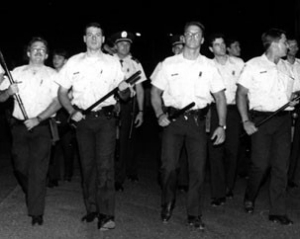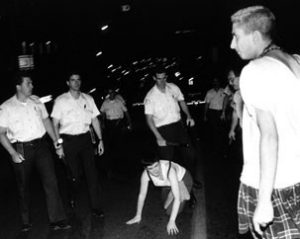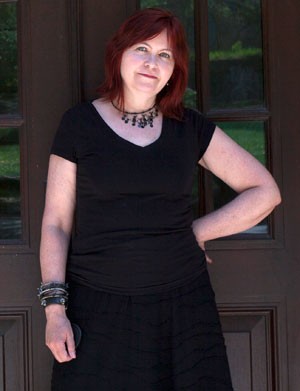“It was chaos,” she says. “People were screaming, people were running. It was dark. To throw that Nikon was a difficult thing. I had to brace myself and say to myself, ‘This is no longer a camera; this is a box with something important in it.’”
A few photos were published the next morning in La Presse and the Montreal Gazette — with the rest locked in a security deposit box to protect the identities of partygoers.
In the following days, the gay, lesbian, bisexual, transgender and queer (LGBTQ) community hosted sit-ins to protest the brutality of the police’s raid. Dozens were arrested, including Hammond — and the LGBTQ community began to organize.
The “Kiss-In” began peacefully with around 250 participants blocking the intersection of De Maisonneuve Boulevard and St-Mathieu Street, shouting slogans such as “We’re here, we’re queer, we’re fabulous.”
The situation eventually turned violent with media and onlookers witness to the forceful arrests of 48 participants. Criminal charges were eventually dropped.
Hammond downplays her role in the events, sticking to the facts — and to her convictions — and calling herself “a photographer with very close ties to Montreal’s gay community, who saw this as a human rights violation and decided to do something about it.”
She is currently writing a short book about her experience, which she hopes to publish in time for Montreal’s pride festivities. “There’s a lot to that story that has never been divulged,” Hammond says.
The LGBTQ community
These days in Montreal it may be hard to imagine a police attack on a person simply because he or she is part of the LGBTQ community, but 25 years ago things were different.
“We want to make sure people don’t forget why all of this started,” says Jean-Sébastien Boudreault, VP of Pride Montreal. “As we look back and see everything we have accomplished, we also see everything that still needs to be accomplished.”
Boudreault stresses the need to support the transsexual movement, whose members “still have a lot of fights to be fought to reach where we are for the lesbians and gays of Canada,” he says.
The Sexgarage incident has been heralded as an important milestone in the development of LGBTQ activism in the city. Pride Montreal credits it as the catalyst for the creation of the Table de concertation des gaies et lesbiennes du grand Montréal, the establishment of a number of annual events: the march and outdoor concerts in 1990, the Black & Blue fundraiser in 1991 and Divers/Cité in 1993.
“It was only 25 years ago police were raiding bars and arresting gays just for being gay,” says Boudreault. “Anybody who was there and had the guts to do what Linda did is a hero. It’s really important to thank her and give her a spot where she can show the world what she did.”
- Montreal’s Pride Parade is Sunday, August 16, starting at 1 p.m. at the corner of Guy Street and René-Lévesque Boulevard.


 Police line-up in preparation for the attack on the partygoers of Sexgarage | Both photos: Linda Dawn Hammond / IndyFoto.com 1990
Police line-up in preparation for the attack on the partygoers of Sexgarage | Both photos: Linda Dawn Hammond / IndyFoto.com 1990
 Police repeatedly harass partygoers on the street outside the party
Police repeatedly harass partygoers on the street outside the party
 Linda Dawn Hammond in front of all that remains of the warehouses near the site of Sexgarage. | Photo credit: Richard Burnett 2015
Linda Dawn Hammond in front of all that remains of the warehouses near the site of Sexgarage. | Photo credit: Richard Burnett 2015